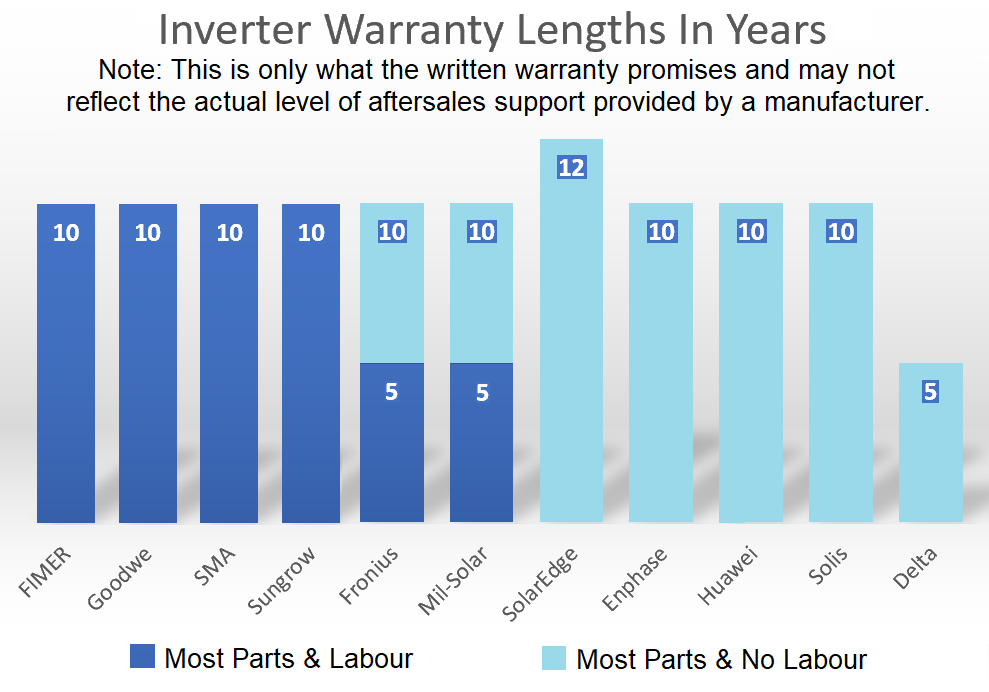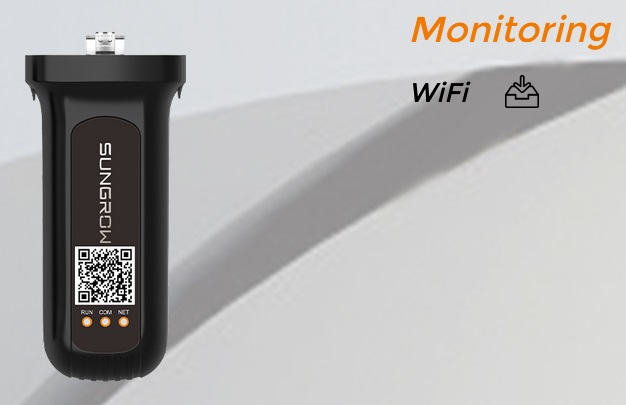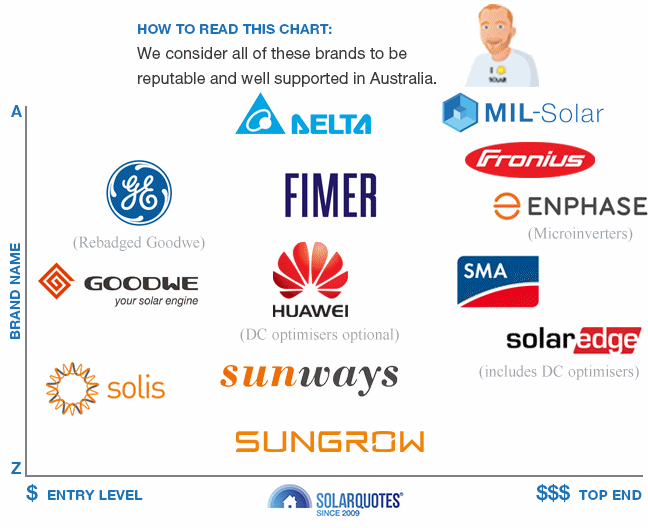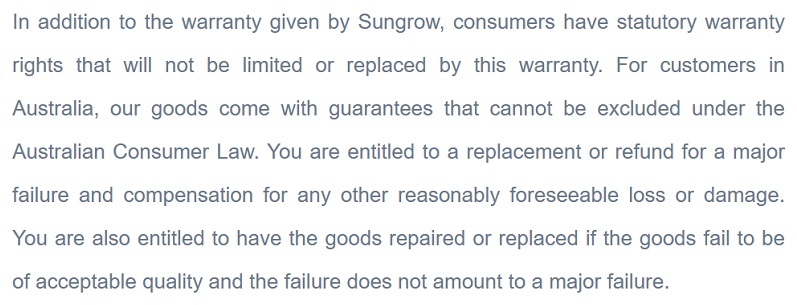
Sungrow is a giant manufacturer of solar inverters. A huge number are installed on and in homes across the country, so it’s a good thing their written warranty is among the best in the industry. Unfortunately, the warranty is still far from perfect.
If you get a solar power system with a Sungrow inverter — or had one installed after around July 2020 — chances are it has a 10 year warranty that covers most components as well as labour and transport.
I’ve already done a deep dive into Sungrow inverters, so this article will be a deep dive into the details of the Sungrow residential solar inverter warranty. I’ll also explain that Sungrow generally goes beyond the words of its written warranty and lives up to most of its obligations under Australia’s Consumer Guarantees. This is why we consider Sungrow inverters well supported in Australia and why they are one of the 12 solar inverter manufacturers we can currently recommend.
Keep reading and I’ll explain:
- How Sungrow’s warranty compares with other manufacturers.
- What the warranty covers and what it — unfortunately — does not.
- How its wireless communications dongle only has a one year warranty.
- Important and/or interesting details in the warranty document’s fine print.
- Why we consider Sungrow inverters to be well supported in Australia and worth using.
You can find the warranty document by visiting this Sungrow page and clicking “Inverter Warranty (10 Years Premium)”. Australia is the only country that receives their premium warranty. This is thanks to our consumer law giving more of a toss about consumers than most places.
Warranty Length
Below is a graph comparing solar inverter manufacturers’ written warranties. Because Sungrow’s explicitly covers labour and many don’t, it is one of the better ones out there:

This graph only shows what the written warranty promises. A manufacturer may provide more after-sales support than the warranty promises. To meet their obligations under Australian consumer law, in many cases, they have to.
I’ve shown this graph before and some people weren’t happy about it. They thought it ranked companies on how much after-sales support they provide, but that’s not what it shows. It merely compares the written warranties and, where they’re identical, the manufacturers are in alphabetical order.
Manufacturers are not limited to only providing the support promised in their written warranties. To be recommended by SolarQuotes, they have to go beyond what their warranties cover and generally meet their obligations under Australian Consumer Guarantees with a minimum of arm twisting. Our Consumer Guarantees provide better protection than any inverter warranty I’ve seen, but Sungrow, along with FIMER, Goodwe, and SMA, have written warranties that come the closest to offering that level of protection.
Dodgy Warranty Support
Tragically, it’s also possible for companies that don’t care about their reputation to not even live up to what’s promised in their warranties. If your inverter is from a dodgy company, when you try to make a warranty claim, their response could be along the lines of…
“Yeah, sorry mate, but what you have here is a warranty for Suk Tin Solar Inverters. That company has no affiliation with us. We are Suk Tin Solar Inverters with a silent “p”. It’s also invisible. And while I know I resemble the General Manager of the company that sold you your inverter, I am actually my own twin brother and have no legal responsibility for your purchase.”
The above may be a slight exaggeration, but more than one company has done a runner from Australia after their products developed problems and left customers to fend for themselves.
Solar Inverters We Recommend
Here is a graphic from our Solar 101 Guide showing the one dozen solar inverter manufacturers SolarQuotes currently recommends:
There are 13 companies on that chart, but General Electric inverters are produced by Goodwe, so there are only 12 manufacturers. We consider all of these to be reliable and well-supported in Australia.
While the lower cost “entry-level” inverters on the left side of the chart may not have the longevity or polished monitoring of the more expensive “top-end” ones on the right, I would expect all inverters from manufacturers on the chart to operate without problem for a minimum of 10 years. If they don’t, I would expect the problem to be fixed quickly and without cost to the homeowner, either under warranty or Australian Consumer Guarantees.
But I also expect the typical solar inverter from a manufacturer on our recommended chart to last longer than 10 years. Just how long depends on how close it is to the right-hand “top end” side. For example, my friend has an SMA inverter on their garage wall that has operated without problem for 20 years.
Note that if there is a problem with your inverter or solar power system, your installer should be your first port of call. But if they’re no longer around, you can directly claim from the manufacturer.
What The Sungrow Inverter Warranty Covers
The Sungrow warranty promises their inverters will be…
“…free from defects in materials and workmanship for a period of ten (10) years from the date of installation of the relevant inverter, but no more than eleven (11) years from the manufacturing date of that inverter (whichever comes first) in Australia only.”
You might think the above claim means that if it develops any problems with materials or workmanship over 10 years you’re covered. Unfortunately, there are components the warranty specifically excludes. Also, as with all inverter warranties, there are a range of exclusions that will render it void. But provided a claim is accepted under warranty, then Sungrow will cover the cost of parts or replacement as well as labour and transport.
The fact they will let the inverter sit in a box in an installer’s storage space for up to a year before the warranty starts is one thing that’s better than most. Many manufacturers only allow three months maximum between manufacture and installation before the warranty clock starts ticking.
What The Warranty Doesn’t Cover
Solar inverter warranties normally exclude a whole range of components from coverage, and Sungrow is no exception. It doesn’t cover:
- Fuses
- Surge suppressors
- Filters
This is a pity because these are among the most likely components to fail. It also states it won’t cover cosmetic damage.
See?
There is also a list of exclusions the warranty won’t cover, and they are all fairly standard for solar inverter warranties. They basically require the inverter to be installed according to the user manual and exclude Sungrow from providing warranty coverage for anything out of their direct control.
The user manuals — also known as installation manuals — for Sungrow inverters say they can be installed outside, but they must be kept out of the rain and direct sunshine. The manuals for their hybrid inverters are an exception, where it becomes a recommendation rather than a requirement.
Its Wireless Dongle Only Has A 1 Year Warranty
In addition to fuses, surge suppressors, and filters being exempt from the warranty, the 10-year warranty also doesn’t cover the inverter’s wireless dongle. Instead, its warranty is only for a single year.

This is what the typical Sungrow wireless dongle looks like. It plugs into the underside of the inverter and allows it to use your wireless modem to connect to the internet.
This one-year warranty applies to all Sungrow wireless communication dongles, smart energy meters, logger devices, and any associated accessories.
An internet connection is required for all new installations in South Australia and may soon be a requirement in other parts of the country. As wireless communication is such an important feature, in my very unhumble opinion, a one-year warranty is not good enough. The only saving grace is the warranty doesn’t require the inverter receive regular internet updates, so if the wireless dongle fails, you won’t risk losing your 10-year inverter warranty.
What Sungrow Will Do
If there is a problem with the materials or workmanship of the inverter and it’s not in the excluded components list or a dongle that died after its one-year warranty expired, then the warranty says Sungrow will either…
- Repair the inverter. Either onsite or at a repair centre.
- Replace the inverter with either a new one or a refurbished second-hand one.
If they only replace components, they can, at their option, use second-hand parts.
Because their range of inverters can change over time, if they replace an inverter with a new one, they will — at their discretion — replace it with their most similar model. The warranty states they will not pay for any changes to the rest of the solar power system that a different inverter model may require.

This image, lifted from Encyclopaedia Britannica, shows how the SUN will GROW into a red giant in 5 billion years’ time. Hopefully, Sungrow won’t take this long to grow its dongle warranty.
Repairer Payments
The warranty is different from most in that it provides figures for payments made to those replacing or repairing inverters under warranty. These payments will normally only be available to installers. They are:
- $150 for a standard site visit. If multiple visits are required, Sungrow must be notified before each one. The amount can be higher for larger commercial inverters. For more information, you can go to this page and click “Service Rebate”.
- Travel costs of up to $200 for standard ground transportation. So if you drive a batmobile, you may be in trouble.
- Up to $200 to pay for transport of inverters or components to Sungrow.
The warranty specifically says they will not pay for “sustenance”, which I presume means “food and/or accommodation”.
Note that while the warranty states these amounts, they may not necessarily be what installers actually receive. It’s like my father used to say, “Not everything is negotiable, but everything is negosh. It’s up to the other side to decide if they’re agreeable to provide an iable.”
You Must Have Proof Of Purchase
If your solar inverter has a problem while it’s under warranty, you should contact your installer. But if that’s not an option, you can use Sungrow’s online warranty claim form. The warranty document says you must provide proof of purchase.
No Compensation For Loss Of Production
The warranty says it won’t cover the cost of any lost solar energy output resulting from a faulty inverter.
It’s Not Transferrable
The warranty specifically says it’s not transferrable, so if you sell your home, you cannot transfer a Sungrow inverter warranty to the new owner.
Australian Consumer Guarantees
So far, this article has been about what the warranty says, but under Australian Consumer Guarantees you have protections that are better than any written inverter warranty I’ve seen. The Sungrow Australian warranty mentions them, as it should:
Note how it says under Australian consumer law you can be entitled to compensation for “…reasonably foreseeable loss or damage”, despite the written warranty specifically saying it won’t cover loss of electricity generation.
If your solar inverter fails during its warranty period and you can’t claim using the written warranty, then — provided it was installed correctly and used normally — I would say there’s an excellent chance you can make a claim under Australian Consumer Guarantees. Provided it’s reasonable, you may even be able to make a claim after the warranty period ends. But note I’m not a lawyer, so this is just my understanding. This is not professional advice on consumer law.
Fortunately, Sungrow will generally live up to its obligations under Australian Consumer Guarantees, which is one important reason why we can recommend using them.
One Of The Best Inverter Warranties — But Could Be Better
Australian consumer law provides better protection than people get in many countries, but it’s still reasonable. Written warranties should provide additional protection. Despite this, I’ve never seen a warranty — for anything, really — that provides as much protection as Australian Consumer Guarantees do.
I think the Sungrow warranty document should — at minimum — provide the same amount of protection you automatically receive in this country when you buy a product for home use. But Sungrow is one of a small group of solar inverter manufacturers whose warranties come closest to that level. They also can generally be relied on to meet their obligations under Australian consumer law. Hopefully, they will further improve their warranty in the future.
But maybe they should start by lengthening their itsy bitsy teeny weeny tiny dongle warranty.




 RSS - Posts
RSS - Posts



Ron, I need to point out that when we had Enphase microinverters replaced under warranty Enphase paid A$25/microinverter to the company doing the work. I thought this was fair enough. I also discussed the travel to and from our home and was happy to pay the contractor for that time myself. I believe this is commonly done by Enphase it was the case on both occasions we have needed microinverters replaced.
All the inverter manufacturers on our recommended chart will normally pay for labour regardless of what their warranty document states. In my not-at-all humble opinion, manufacturers should simply update their warranty documents so they cover labour (in Enphase’s case the warranty document bizarrely explicitly states labour is not covered) It’s obviously going to be better for sales to do so.
RE SUNGROW DONGLE –
I am in this situation NOW. Dongle goes offline every few months and each time has reconnected to wifi by itself. Now it won’t, despite restarting everything, several times, the dongle stays offline, has for months.
The single phase hybrid inverter still works – I think – but without being able to monitor, I can’t be sure. Sungrow said to buy a wifi extender, which I’ve done, but I really need more powerpoints to be able to plug it in first – ie electrician to install more powepoints (so ext cable not draped everywhere), to see if the dumb dongle will connect to the wifi extender –
The single phase inverter is out of warranty, the dongle CANNOT be replaced If the dongle is stuffed, it’s a NEW INVERTER, just to be able to monitor the PV – Hah ?
What am I meant to do? How do I find a good ELECTRICIAN just to install powerpoints, so I have a powerpoint in the right spot to plug in a damn wifi extender, just to see if the dongle will connect to it ?? Catch 22 –
Hi Sharon,
I am just a IT guy who also has a SunGrow Inverter installed at my home. I did not trust WIFI to reach my Inverter location reliably so I had my Installer run a Cat 5 ethernet cable from my Switch/Router directly to the Inverter network dongle and it has never had a problem.
A Wifi Extender may fix your connectivity problem but if you dongle supports a direct Ethernet cable that may be a better option.
I hope that help
Matt
I do love the idea of a physical cat 5 cable instead of relying on wifi.
If I were in that boat, I’d run the cable, wouldn’t be hard for us.
(HOWEVER for some people it would be very difficult to get a cat 5 cable to the inverter, so wifi connected devices need to have reliable wifi.)
We’re not currently in that boat, as we have a prehistoric solar system, old and tired, and an inverter that’s nearly (though not quite) as old, as sadly the original Xantrex failed- and warranty support was basically non-existant.
DQ started installing our Sungrow system today. I was discussing WiFi with the installer and considering which of our two networks to connect to when I spotted the RJ45. Quick re-jig of plans and now we’ll have the pair of inverters connected via cabled LAN. Saves so many issues with restarts and other hiccups.
I also noted the WiFi dongle plugs into the inverter using an RJ45 anyway. Does this mean it’s possible to bypass the dongle and just patch directly @ the inverter?
Bypassing the wireless dongle with a communication LAN cable is a good option where it’s easy to do. I will update the article with that suggestion. Thanks!
UPDATE: Looks like this isn’t a good idea because, as the LAN cable plugs into the bottom of the wireless dongle.
Hi Ronald, looks like the RJ45 LAN needs to be plugged into the bottom of the wireless dongle even though the dongle itself connects to the inverter though an RJ45 mech(?). Sorry mate, but looks like the dongle might be the brains of the outfit. Which is not good if that’s the weakest link…
Oh dear. There’s always something, isn’t there? Thanks for pointing that out.
Hi Sharon
Getting a new power point might cost a couple hundred dollars or potentially more depending on what has to be done. But you can use an extension cord to test if a wireless extender will help before investing in a new power point. Unfortunately, there is a good chance the inverter’s wireless dongle is dead and no wireless extender will be able to help it.
If it’s a Sungrow inverter it should have a screen built into it that you can check to see if it’s still working. If it doesn’t have a screen you can check your electricity bills to see if you are still getting a solar feed-in tariff. By comparing the number of kilowatt-hours exported from the same period in pervious years can give you an idea if the system is performing acceptably. While this is a sub-optimal solution, it is low cost.
There are also wireless devices which use a clamp over the cable which measure power fairly accurately, such as the Efergy. Whilst it doesn’t know the difference between power in vs power out, if you have it connected to the main you can usually guess which way the power is going.
Alternatively, connect the clamp just on the solar output, and you’ll at least know what the inverter is producing.
I would hate to have a totally unmonitored system- it could fail and you might not know for weeks unless you specifically looked at it.
There is a ethernet cable in these inverters too (under the dongle attachment location – my installer left me the cover) why did you not mention this?
And is this inclusion of an ethernet port as standard (at least on our 5kw inverter) a differentiator that other manufacturers don’t include?
When my dongle dies it’ll get ethernet connection which will be much more reliable (generally) in the longer term.
I need to have a Cat 6 cable run for when we eventually go FTTP to basically same locations so two cables doesn’t cost twice the amount to pull through a house, and I’m sure would cost less than a replacement dongle.
If your dongle is dead either look up your inverter to see what specs it has – ie a n RJ45 ethernet port, or unscrew the dongle and have a look inside the where it attaches
Hello again, Sharon.
As David and Simon have pointed out, it will often be possible to run an ethernet cable from the inverter to the modem. A solution I overlooked. (Clearly, I should have asked my co-worker Anthony to give advice, as he is much more practical than I am.)
Sure their warranty might be top notch, but their security is lax. They are a chinese GOVERNMENT owned company. No way i’d install one. Absolutely no way id also use the wifi dongle linking it to all my wifi data!!
Hello Bryce. Sungrow is a publicly traded company. The 5 largest owners and their percentage of shares are:
Ren Xian Cao (founder) 9.99%
GF Fund Management Co., Ltd. 7.4%
Luzhou Huizhuo Enterprise Management Partnership LP 4.86%
China Merchants Fund Management Co., Ltd. 2.22%
Zhong Ou Asset Management Co., Ltd. 1.8%
Link:
https://www.marketscreener.com/quote/stock/SUNGROW-POWER-SUPPLY-CO–11367321/company/
So are you saying you wouldn’t connect ANYTHING made in China to your Wifi?
That rules out an incredible amount of gear, from televisions to security cameras ….. to about 95% of other gear.
If that’s really a valid concern, then we’re in deep you know what!
I am in the process of buying a house that has 20 solar panels on the roof. The house was flooded in February 2022 and the inverter has been ripped out, I have no idea what brand it was , or what brand the panels are, and I am not about to climb on the roof to find out, The agent is also useless I have enquired about buying an inverter from several companies, but they will not sell just an inverter, they want to sell the entire array which I do not want,or need. Any ideas ?
As the inverter was removed and not replaced, it suggests the owner didn’t think the system was worth salvaging. I’m afraid very few installers will want to repair a flood damaged system installed by someone else. This is because they will have to sign off on it being safe and they generally won’t want to do that for someone else’s work. It’s not impossible to find an installer who is willing to carefully inspect it and give it the okay if it is okay, but it will be difficult. You will have to pay for that inspection and any work that needs to be done to bring them up to standard.
Because you will receive the subsidy for solar if you install a new system, but not if you repair the old system, you may be better off with an all new one. This will give you an up to date system with all new warranties.
Those panels may only be a couple of years old and be high quality, or they could be badly degraded 10 year old low quality panels. Because no information is available, that increases the probability they are old. If they are visible from the ground, you can inspect the panels with binoculars for obvious damage. If you have access to a drone you can use that. You also want to check if they are neatly installed because if they were put in by someone who does shoddy work, they probably aren’t worth saving.
If you decide to get a new system we can refer you to quality installers. If you want to find someone to inspect the existing panels and perhaps okay them, we can also see if someone is available. Go here and enter your postcode…
https://www.solarquotes.com.au/quote/start/
…and click on repairs and maintenance. Explain you want someone to inspect the panels and, if they are in good condition, replace the inverter to give you a functioning solar system. We can check if there is someone available in your area, but we can’t guarantee we’ll be able to find one. I do think the odds are you’ll be better off writing it off and getting a new system.